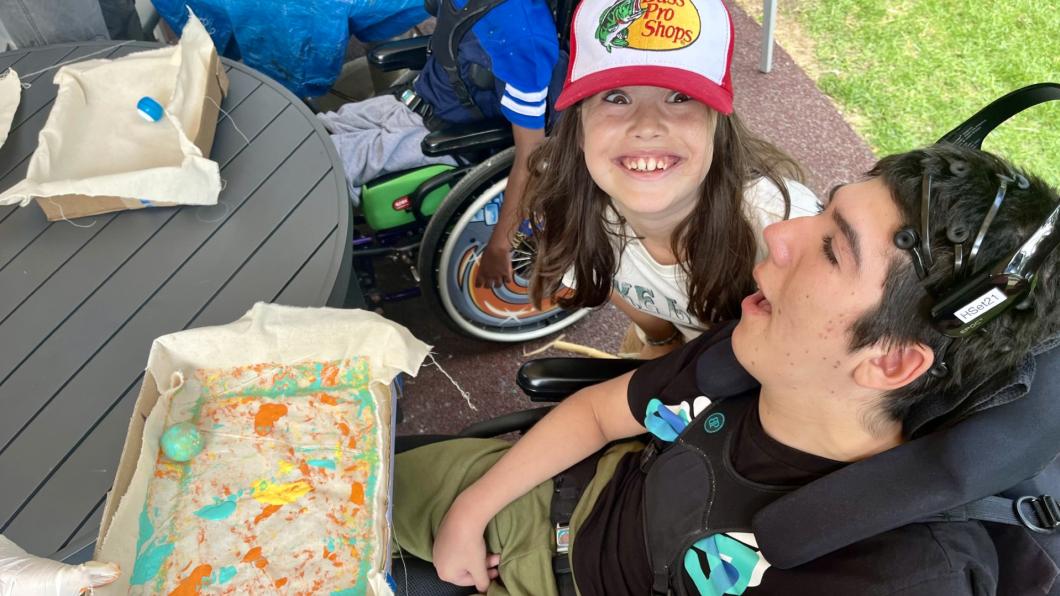
Sensor headset allows teen to control devices with his thoughts
Seth Tolensky moves a robotic ball in paint by thinking, amazing his sister Audrey.
By Louise Kinross
Seth Tolensky doesn't speak and can't hit a switch or use a voice device to communicate.
The Toronto teen can use a brain computer interface (BCI) that translates his thoughts into control of technology, and it's giving him a new sense of agency.
Wearing a sensor headset that identifies electrical brain patterns calibrated to play music on a phone or tablet, paint with a robotic ball or race a remote-control car means Seth can "do something all by himself, without help, just by thinking," says his mother Melanie.
The BCI "is essentially a fancy switch that doesn't require any physical movement or verbal communication to activate it," says Susannah Van Damme, an occupational therapist and team lead for the clinical BCI program at Holland Bloorview. "The right to play is our cornerstone. We have kids for whom the world is not accessible for them to play. This is the technology that can bridge that gap."
In preparing a child to use the system, the interface records the child "not thinking about anything in particular, just calm thoughts," Susannah says. The child is then asked to pick a thought about movement. It could be clapping or going fast in their wheelchair. Seth, who loves sports, likes to think about dribbling a basketball or swimming.
The active thought becomes the command signal which is linked by software developed at Holland Bloorview to an electronic device. It could be turning on a bubble machine or sending a space bar signal to a video game so a character jumps.
Susannah says children get better at using the BCI with practice. "We have kids use it in an outpatient six-week therapeutic recreation program, and they get more accurate and use it more quickly and more reliably over time." But the goal of the clinical program is "engagement in fun activities. The outcomes we're looking for are joyful engagement."
Melanie notes that the BCI allows Seth's personality to shine. When using it to drive his wheelchair in one direction, scientists asked him to stop when he faced researchers, therapists, his nurse and mother, who were standing in a circle around him. But he kept zooming past his mother. "He got better and better at stopping at each person, but he kept racing past me," Melanie says. "When I finally called him out on it he stopped in front of me with a big smirk. It was a funny moment."
To drive his wheelchair, Seth uses thoughts of dribbling a basketball to drive in one direction, imagines swimming to drive in the other, and calms his mind to stop. Previously Seth was pushed in a manual chair by someone else. "With the BCI, he’s driven his wheelchair through Bloorview halls, from top floor into the elevator, out and all the way around the main level right outside into Spiral Garden," Melanie says. "It’s pretty amazing.
Melanie says people used to underestimate Seth, 15, who has a rare genetic condition. "We have used videos of his BCI accomplishments to show his teachers, therapists and friends what he can do. Seth doesn’t communicate with words and people often don’t believe he understands and thinks at his age level. It’s often a struggle in school. Once they see Seth use BCI, they see him differently. They believe in him more and treat him as someone who is capable."
Susannah says the greatest challenge of the interface headset is that it wasn't developed with children with disabilities in mind.
"This headset is 'one size fits all' for adults, because it's currently used commercially for meditation and mental performance tracking in adults. We've found it doesn't work for all head shapes. A big frustration is that it's not easy to calibrate it for people who have thick hair or textured hair, which is a bias in the technology. We troubleshoot that by using different types of felt in the sensors that are easier to position right up against the child's scalp."
Susannah is working with scientists in the Bloorview Research Institute and beyond to publish studies that show how the device can benefit children. Families are eager to see development of future applications that could aid communication and mobility.
Read more about the brain computer interface. Or e-mail bci@hollandbloorview.ca. Like this content? Sign up for our monthly BLOOM e-letter, follow @LouiseKinross on Twitter, or watch our A Family Like Mine video series.